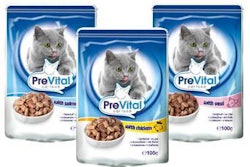Only about 10% of the 30,000 new product concepts developed in the US actually make it to market each year, according to Nielsen. So why do so many companies, including petfood and treat manufacturers, continue to pour so much R&D money into new product development?
For one reason, in an industry like petfood -- and especially in a mature market like the US -- new product development continues to drive sales. More and more pet owners treat their pets like family members, and that means they want to continually try and buy the latest and greatest products for Fluffy or Fido.
Also, "success" is a relative term. Even Nielsen, in its latest "Breakthrough Innovation Report," concedes that there is "no shortage of successful incremental innovations that generate compelling returns for their managers and owners. They keep brands fresh and relevant."
To determine its list of 14 breakthrough innovation winners for 2013 -- though all were launched in 2011 -- Nielsen says it analyzed 3,439 consumer products introduced in the US that year. To land on the list, a product had to meet three requirements:
- Distinctiveness -- deliver a truly new value proposition to the market; things like ingredient reformulations, new packaging or repositioning didn't cut it.
- Relevance -- generate at least US$50 million in its first year of sales.
- Endurance -- achieve at least 90% of those first-year sales in year two.
Among those mega-million brands making the grade from 2011 (and announced as breakthrough innovation winners this year) is Milo's Kitchen dog treats, a Del Monte brand. When I saw that name among the 14 winners, I have to admit my reaction was, huh?
Don't get me wrong, I have nothing against the brand or the treats. They easily met Nielsen's sales thresholds, exceeding US$75 million the first year and blowing past $US100 million in sales the second year. And they seem to hold true to their marketing platform of being all-natural, "real" treats that closely resemble their names: Beef Sausage Slices with Rice, Beef Jerky and Chicken Meatballs. (A fourth product, a Chicken Griller/Chicken Jerky Recipe, was recently pulled from shelves in a voluntary recall after traces of antibiotics were found. Del Monte says the products are perfectly safe.)
My problem is seeing how Milo's Kitchen met Nielsen's "distinctiveness" requirement. Among all the natural, "home-style," fresh-meat-like treats on the market, these products just don't seem particularly innovative or unique to me.
Judging by its report, I think Nielsen, perhaps unofficially, also gives some weight to each winning company's new product development process. The report emphasizes that breakthrough innovation means demand-driven innovation, which has three disciplines: demand-driven insight, demand-driven development and pervasive leadership. It then fleshes out each discipline. (You can request to download the report.)
Perhaps the most interesting part of the report are spotlights on some of the winners, including Milo's Kitchen. The report quotes Geoff Tanner, Del Monte's vice president of innovation, describing how the product was developed, including a "disruptive insight" (Nielsen's phrase, not Tanner's) uncovered in consumer research on dog owners' attitudes about their pets' favorite treats. Unfortunately, you won't find any big revelation here, because the report doesn't really explain what that insight was. (I guess you can't blame Del Monte for keeping that under wraps.)
Tanner also discusses how the company developed a sort of "skunk works," a small team dedicated to researching and developing the new line, and convinced management to go all in on the development and launch, with a full "media campaign, putting the team on a plane to meet with our channel partners, executing in store and engaging the sales force," Tanner says. He adds that the success of the launch has "played a part in building a more robust innovation runway at Del Monte."
Good for Del Monte, and good for all the other winners on Nielsen's list. But to me, Nielsen seems to be pushing the message that, from the requirements to be named a breakthrough innovation product to all the factors credited for the winning products' achievements, big money is the single most important element to new product success. And I think we all could cite examples on the market today of truly innovative, distinctive products that were developed, launched and marketed on much more modest budgets and still succeeded wildly in their respective niches.


















